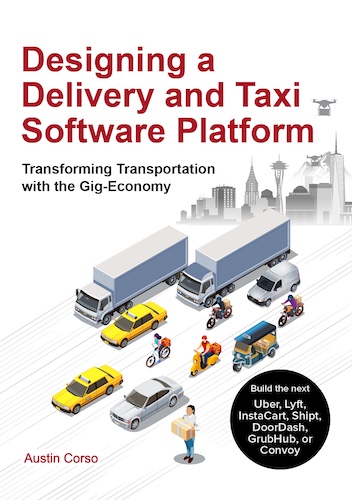The sharing economy has given rise to a wave of new online multi-sided marketplace apps and business models, where consumers and sellers are matched across a unique, differentiated set of products and services. In this series, we will explore the applications, domains, and software subsystems applicable to a wide variety of transportation use cases – from restaurant and grocery delivery (e.g. DoorDash, Instacart), to taxi and rideshare services (e.g. Uber, Lyft), to third-party deliveries and shipments (e.g. Shipt, Convoy, Uber Freight).
Specifically, we will design a three-sided gig-economy marketplace and transportation software platform that matches:
- Customers, making purchases and requesting rides
- Third-party vendors, including merchants and taxi services
- Gig-economy drivers, delivering goods and people
A range of transport timeframes will be supported – from same-hour to several days out. Drivers can choose to schedule work in advance to guarantee sufficient working hours or work on-demand for maximum flexibility, obtaining work in real time. Multiple competing goals must be balanced: low-latency, cost-efficient fulfillment with accurate ETAs for customers; consistent, high-availability delivery and transport for vendors; and fairness, transparency, and flexibility for drivers.
We will explore the platform’s end-to-end architecture, including:
- Product flows across web and mobile apps
- Backend systems, APIs, and event-driven services
- Core domain models, such as order management, route planning, dynamic pricing, ETA prediction, driver-route targeting and matching, forecasting, and payments
- Infrastructure strategies, such as horizontal scaling, observability, reliability, multi-region fault isolation, service discovery, networking, and security
- Machine learning services for forecasting and optimization
- Technical analysis of design patterns, consistency models, data modeling, and technology choices
This is primarily intended for software engineers designing large-scale gig-economy platforms, but introduces complex topics in an approachable manner for anyone in technology – from experienced software engineers designing their long-term platform architecture and technical roadmap, to aspiring software engineers learning distributed systems and evaluating design trade-offs, to product managers and technical leaders designing gig-economy products and long-term strategies.
By the end, readers will gain expertise in designing, scaling, and operating a global transportation platform that matches customers, vendors, and drivers in real time, under real-world constraints.
Lets dive into Part 1: Introduction, Requirements, Mobile and Web Applications.
- Part 1: Introduction, Requirements, Mobile and Web Applications
- Part 2: Backend Infrastructure and Service Architecture
- Part 3: Vendor Management and 3rd Party Customer Shopping & Checkout
- Part 4: Transport Supply & Demand Management and Forecasting with Machine Learning
- Part 5: Route Planning, ETAs, and Dynamic Pricing with Machine Learning
- Part 6: Driver Onboarding, Preferences, Standings, Rewards, and Payments
- Part 7: Driver-Route Targeting, Pushed On-Demand Routes, and Precomputed Eligibility
- Part 8: Gig-Economy Route Marketplace for Schedule-Ahead Routes with Deferred Route Matching
